The Intel Skylake-X Review: Core i9 7900X, i7 7820X and i7 7800X Tested
by Ian Cutress on June 19, 2017 9:01 AM ESTBenchmarking Performance: CPU Rendering Tests
Rendering tests are a long-time favorite of reviewers and benchmarkers, as the code used by rendering packages is usually highly optimized to squeeze every little bit of performance out. Sometimes rendering programs end up being heavily memory dependent as well - when you have that many threads flying about with a ton of data, having low latency memory can be key to everything. Here we take a few of the usual rendering packages under Windows 10, as well as a few new interesting benchmarks.
Corona 1.3
Corona is a standalone package designed to assist software like 3ds Max and Maya with photorealism via ray tracing. It's simple - shoot rays, get pixels. OK, it's more complicated than that, but the benchmark renders a fixed scene six times and offers results in terms of time and rays per second. The official benchmark tables list user submitted results in terms of time, however I feel rays per second is a better metric (in general, scores where higher is better seem to be easier to explain anyway). Corona likes to pile on the threads, so the results end up being very staggered based on thread count.
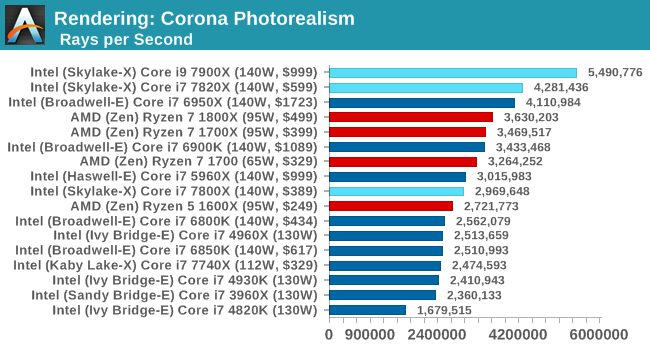
Blender 2.78
For a render that has been around for what seems like ages, Blender is still a highly popular tool. We managed to wrap up a standard workload into the February 5 nightly build of Blender and measure the time it takes to render the first frame of the scene. Being one of the bigger open source tools out there, it means both AMD and Intel work actively to help improve the codebase, for better or for worse on their own/each other's microarchitecture.
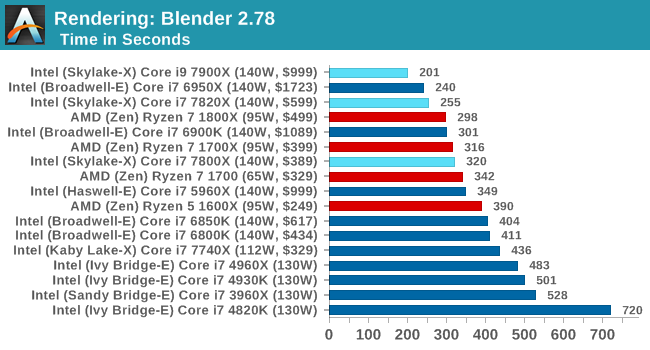
LuxMark
As a synthetic, LuxMark might come across as somewhat arbitrary as a renderer, given that it's mainly used to test GPUs, but it does offer both an OpenCL and a standard C++ mode. In this instance, aside from seeing the comparison in each coding mode for cores and IPC, we also get to see the difference in performance moving from a C++ based code-stack to an OpenCL one with a CPU as the main host.
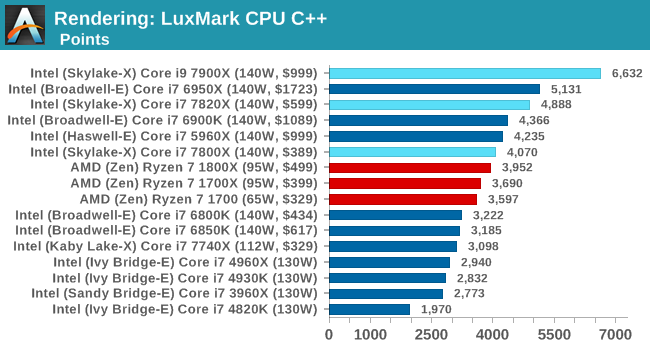
POV-Ray 3.7b3
Another regular benchmark in most suites, POV-Ray is another ray-tracer but has been around for many years. It just so happens that during the run up to AMD's Ryzen launch, the code base started to get active again with developers making changes to the code and pushing out updates. Our version and benchmarking started just before that was happening, but given time we will see where the POV-Ray code ends up and adjust in due course.
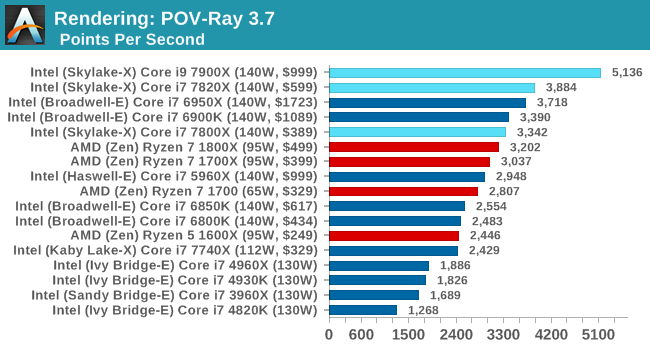
Cinebench R15
The latest version of CineBench has also become one of those 'used everywhere' benchmarks, particularly as an indicator of single thread performance. High IPC and high frequency gives performance in ST, whereas having good scaling and many cores is where the MT test wins out.
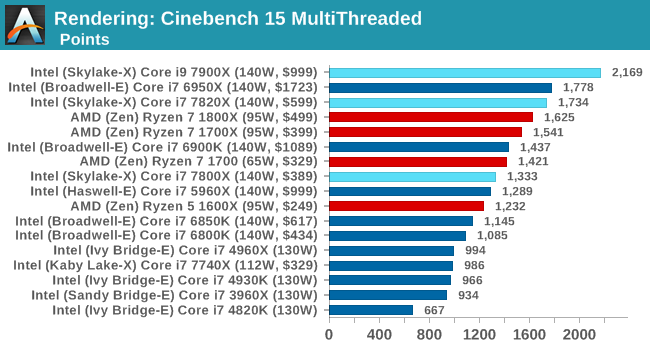
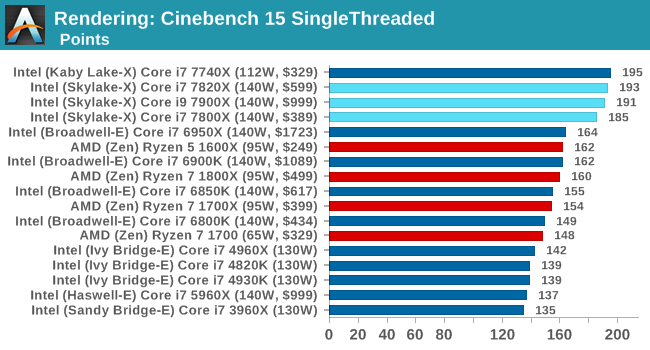










264 Comments
View All Comments
Icehawk - Monday, June 19, 2017 - link
I'm curious to see AMD's response w/Threadripper but the 7820 is looking like the next CPU for me, I'm still on a 3770k and while it is just fine for gaming I've been converting all of my media to x265 and need a lot more muscle to speed that along. I do wish that heat was better controlled as my current system is near silent with a fanless PSU, an AiO water cooler, no mech drives, etc and overclocked to 4.4ghz.Pieter123456 - Monday, June 19, 2017 - link
Funny how you did not hold of on making a verdict when there were bios and 1080p gaming issues with ryzen launch??!Flying Aardvark - Monday, June 19, 2017 - link
Intel pays well for such courtesies. AMD, not so much. I heard people saying Ryzen was released defective.So the conclusion that AT should be making is that the new i7 and i9 lineup was released as defective.
tamalero - Monday, June 19, 2017 - link
I heard you, I still remember how fanboys and some "socialites" of the hardware sites bashed AMD nonstop on other issues, like the voltage issues on the Polaris chips.Nvidia has a problem too, and they arent even close to be that harsh.
Ryzen's cache issue? THE WORLD IS ENDING FOR AMD!!!
Intel's drop in performance core per core in some things? "not that bad, balance, etc..etc.."
Gothmoth - Tuesday, June 20, 2017 - link
the biggest issue is this insane heat skylake-x produces when overclocked.the bios issues can be resolved.
that anandtech is more biased towards intel should come as no surprise.
tamalero - Tuesday, June 20, 2017 - link
I noticed that, there is a huge difference in the wording on this article vs the one in tomshardware.And both show very different outcomes.
Specially in overclocking and power consumption. Where the corei9 is ridiculously inefficient.
Luckz - Tuesday, June 20, 2017 - link
"there is a huge difference in the wording"And knowing Tomshardware from decades ago, I would have expected the exact opposite.
Ryan Smith - Tuesday, June 20, 2017 - link
To be clear here, our Ryzen article didn't have any gaming coverage either.http://www.anandtech.com/show/11170/the-amd-zen-an...
That launch was based solely on desktop usage & compute, in big part because there were so many weird things going on with gaming. In this article we actually went one step further by specifically recommending that gamers not buy SKL-X for the time being.
Gothmoth - Tuesday, June 20, 2017 - link
but no really critical word about the crazy temps.how i am supposed to cool this cpu on air?
and no real critic that intel uses stupid thermal paste..... overall the critical stuff like crippled PCI lanes need to be adressed more agressive.
tamalero - Monday, June 19, 2017 - link
The TDP differences are insane!